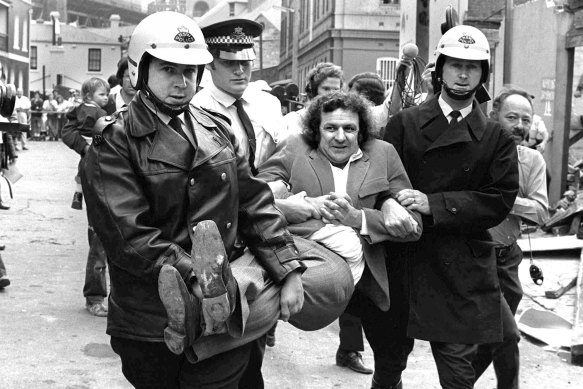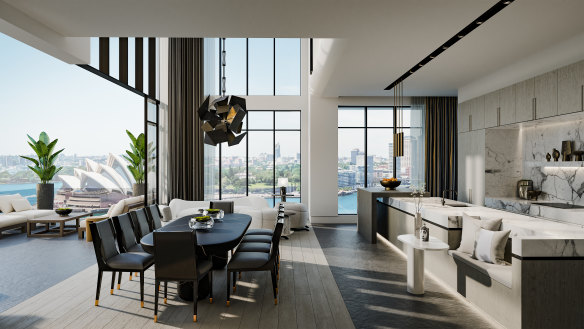This was published 3 years ago
Opinion
Siriusly Sydney? What a way to mark the anniversary of one of people power’s great triumphs
Helen Pitt
JournalistSydney ... sometimes you sicken me. On the very day that marks the 50th anniversary of the world’s first green ban in 1971 to save Kellys Bush – a precious remaining tract of bushland west of the Harbour Bridge – we awoke to news that would have horrified Jack Mundey and his union comrades.
Three years after the last of the Sirius building’s housing commission residents were moved out, its new penthouse level apartment has been sold for $35 million.

Jack Mundey being carried from a protest at The Rocks in the early 1970s.Credit: Robert Pearce
Who can forget the image of Mundey being carried by police and arrested in an attempt to save The Rocks from the developers’ wrecking ball? Or the fact the Sirius complex, when built in 1978-79, became home to many of the original Rocks and Millers Point residents after Mundey’s Builders Labourers Federation and then premier Neville Wran struck a deal to rehouse them. They had fought alongside the unionists to retain the buildings and the working class character of this historic area.
Designed by Housing Commission architect, Tao Gofers, his original plan was to finish the Sirius building in a white colour to match the nearby Sydney Opera House. The prototype was based on Gofer’s other public housing development, The Laurels in Sans Souci in Sydney’s south, which was also white. But due to budget constraints, the building was finished unpainted.
I’ve often wondered if a coat of white paint would have helped protect our city’s most vulnerable, who were rehoused to other suburbs away from family and friends?
Because if it had been white and had mirrored the Opera House as originally intended, visitors and dignitaries would have noticed it. The public may have paid more attention to it – and maybe even put it on the UNESCO World Heritage list, like Jorn Utzon’s design.

An artist’s impression of the $35 million penthouse in the Sirius building.
As it was, the NSW government refused to heritage list the brutalist building, despite a unanimous recommendation from the Heritage Council to do so.
I find it sad that the working-class community in The Rocks which Ruth Park made famous in her novel Playing Beatie Bow and was brought to life recently on the stage at the nearby Sydney Theatre Company, is all but gone from the streets of the area.
It seems a distant era of Sydney now, which has disappeared like the “One Way, Jesus” sign that graced former Sirius resident Owen McAloon’s apartment. Everyone who went across the Harbour Bridge saw that sign and, I dare say, like me, felt a pang of pride we lived in a city where the poorest people had one of the best harbour views in the world.
Gone too like Jack Mundey, who died last year but who 50 years ago on June 17, 1971, joined with Hunters Hill residents and bravely created the green bans movement that went all around the world with one simple message: people have the power to say “stop” to save their communities. What power do they have now?
Opinion newsletter
Opinion takes on the week’s most debated topics with views that will challenge, champion and inform your own. Sign up to receive it every Thursday.